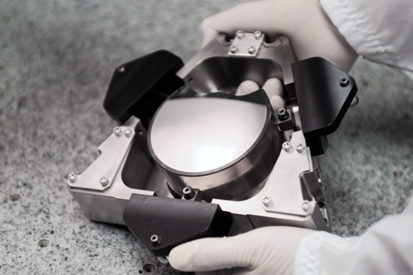Ultra-Precision Optics
Precision optics are essential to orbiting space telescopes as they reveal the outer reaches of the surrounding Universe. Demand for those tolerances is having an impact on down-to-earth lithography technology used in producing semiconductors.
A collaborative effort has been established that meshes the talents of NASA's Goddard Space Flight Center with leaders in semiconductor manufacturing. By leveraging U.S. government and semiconductor industry resources, the program is expected to yield unprecedented advancements in reflective optics for the semiconductor industry.
The collaborative effort involves Goddard, SEMATECH, Silicon Valley Group Lithography (a division of Silicon Valley Group), and SVG-Tinsley. This four-party research and development initiative--dubbed the High Precision Optics Joint Sponsored Research Agreement (JSRA)--is to harness the wherewithal to create the most advanced microlithography machines to date. Lithography is a process that makes possible the printing of tiny electronic circuitry, such as those used in powerful computer memory chips. Higher precision optics of benefit both to NASA and for advancing optics used in lithography are being realized by the JSRA. The JSRA also involves the pooling of resources to reduce costly research and development expenditures.
An early decision was made to use extreme ultraviolet (EUV) light for a prototype lithography optics design. Tolerances for EUV optics form accuracy requirements that are typically five times more stringent than for lithography systems currently in production.
The JSRA was stimulated, in part, by the Richmond, California-based SVG-Tinsley's successful fabrication of ultra-precise corrective optics for the space agency's Hubble Space Telescope that was deployed in 1990. Astronomers were at first dismayed when they found the space telescope's primary mirror flawed. That problem greatly impaired the optical vision of the orbiting eye-in-the-sky. To correct Hubble's focus, SVG-Tinsley was assigned by NASA the critical task of making sets of coin-sized mirrors exhibiting extremely smooth surfaces. These corrective optics permitted Hubble's full and fabulous telescopic power to be realized.
In the government-industry collaboration, Silicon Valley Group Lithography (SVGL) of Wilton, Connecticut, plays the role of systems integrator. SVGL will apply newly developed ultra-precision technologies to future microlithography products. This higher precision enables lithography systems to yield breakthrough optical performance, resulting in higher productivity, improved overlay, increased process latitude, and a larger exposure field.
Goddard brings to the collaboration ultraviolet mirror coatings, special test facilities, analytical modeling, and other technical know-how. SVG is a leading manufacturer of automated wafer processing equipment for the worldwide semiconductor industry. The company designs, manufactures, and markets technically sophisticated equipment used in the primary steps of making semiconductors. SEMATECH is a consortium of U.S. semiconductor manufacturers. SEMATECH works with government and academia to sponsor and conduct research aimed at assuring the country's leadership in this high-technology arena.
This collaborative powerhouse is expected to benefit state-of-the-art technologies, be it in microlithography or scanning the heavens above in never-before-seen detail. "Continuing improvements in optics manufacturing will meet unique NASA requirements and the production needs of the lithography industry for many years to come," notes Noreen Harned, SVG's director of corporate lithography marketing.

Extreme ultraviolet (EUV) light enables greater accuracy than current lithography systems.













